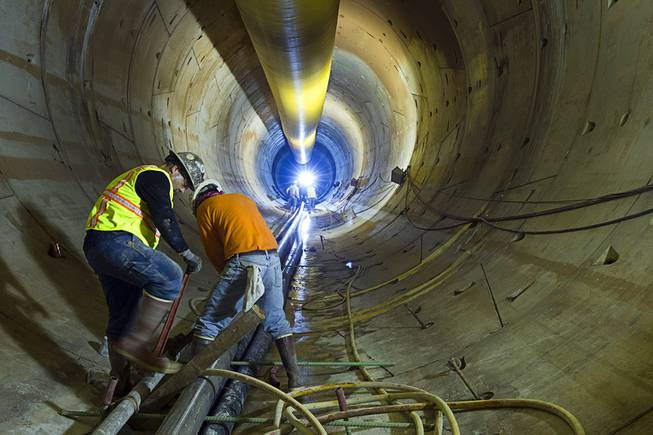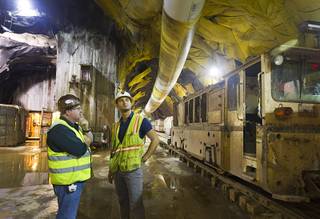
Workers connect pipes that will be used for water-quality monitoring and prevention of quagga mussels in the third intake tunnel Monday, June 1, 2015, under Lake Mead.
Monday, June 1, 2015 | 6 p.m.
Six hundred feet down an elevator shaft near the shore of Lake Mead, the weight of Las Vegas’ future rests on a 19,000-pound plug at the mouth of a three-mile tunnel.
The plug sits atop a domed cavern beneath the lake, holding back the pressure of millions of acre-feet of water.
Later this summer, the tunnel will be flooded and a crane will pull out the plug, connecting the lake's third intake straw to nearby pumping stations and providing a new level of protection against a blistering drought that has sent Lake Mead's elevation to record low levels.
The new intake — basically a steel and concrete tube that uses gravity to feed water into the valley's pumping facilities — will keep working even if the lake's elevation drops below 1,000 feet, a point at which two already existing intakes will have stopped functioning. With Lake Mead's elevation currently at 1,076 feet and dropping, the third intake provides a much-needed insurance policy to ensure the drought doesn't cut off the source of 90 percent of Las Vegas' drinking water.
"From our standpoint, we needed to make sure we secured that supply and access regardless of what the lake level is. That's what this facility does," said Bronson Mack, spokesman for the Southern Nevada Water Authority, which is building the intake.
During a tour today, media members got an up-close look at the tunnel and third intake before it's filled with water in late August or early September. With only a few months to go, more than a dozen workers were still toiling in the hot and humid tunnel environment. Construction is mostly complete, but crews are still installing a set of concrete encased pipes that will carry chemicals needed to protect the intake from invasive quagga mussels and will allow the SNWA to check water quality.
Pulling the plug situated at the end of tunnel will be the final step of a seven-year, $817 million project that has seen construction crews pull off a feat of engineering unlike anything else in the world.
The process started with a 600-foot access shaft excavated and blasted straight down near the shore of Lake Mead. From there, 14-person crews traded off guiding a 620-foot, 1,700-ton tunnel boring machine along a three-mile route under the lake. Progress has been slow moving, at a rate of about 35 feet per day. Several floods, cave-ins and setbacks along the way have led to delays and forced engineers to rejigger the tunnel's path. There's also been tragedy following the death of a construction worker in 2012 who was struck in the head by a pressurized jet of grouting material that was ejected when one of the concrete rings lining the tunnel slipped.
In December, the boring machine reached the end of its route and pierced the intake structure that had already been sunk to the bottom of the lake, ending up only millimeters off its intended target.
While it would be tempting to step back and relax after completing such an expensive and technically challenging project, Mother Nature has left the SNWA with little time for celebrating.
Already, planning and design are underway on the next major project at Lake Mead, a $650 million pumping station that, like the intake straw, is meant to replace older, already existing facilities that will eventually be rendered useless by falling lake levels.
"When you couple intake No. 3 with the low lake level pumping station, we'll be able to draw water from below the deadpool elevation of 875 feet," Mack said. "That allows us to continue accessing our water supply even if no water is able to pass through Hoover Dam for downstream users in Arizona, California and Mexico."


Join the Discussion:
Check this out for a full explanation of our conversion to the LiveFyre commenting system and instructions on how to sign up for an account.
Full comments policy